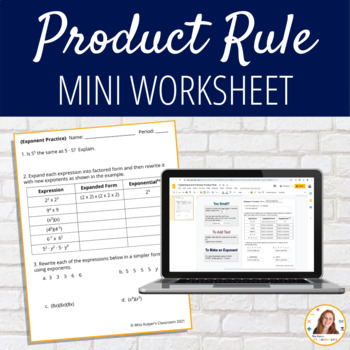Miss Kuiper's Classroom
1.1k Followers
Grade Levels
8th - 10th
Subjects
Resource Type
Standards
CCSS8.EE.A.1
CCSSHSN-RN.A.1
CCSSHSN-RN.A.2
Formats Included
- PDF
- Google Apps™
- Easel Activity
Pages
6 Pages
FREE
Miss Kuiper's Classroom
1.1k Followers

Includes Google Apps™
The Teacher-Author indicated this resource includes assets from Google Workspace (e.g. docs, slides, etc.).
Easel Activity Included
This resource includes a ready-to-use interactive activity students can complete on any device. Easel by TPT is free to use! Learn more.
Also included in
- Are you introducing Exponent Rules? Miss Kuiper's Classroom has you covered with this exponent rules worksheet & guided notes! In this worksheet exponent rules such as Product Rule, Quotient Rule, and Power to a Power Rule will be explained.Products Included:Aligned Common Core StandardsGuided NPrice $6.00Original Price $9.75Save $3.75
Description
Are you introducing Exponent Rules? Miss Kuiper's Classroom has you covered with this exponent rules worksheet all about multiplying numbers with exponents: The Product of a Power Rule.
Included:
- Aligned Common Core Standards
- Mini Worksheet
- Digital Version Worksheet (Google Slides)
Check out these other great activities!
SAMPLE: Solving Equations Task Cards
Solving Two-Step Equations Maze
⭐ Connect with Me! ⭐
Total Pages
6 Pages
Answer Key
Not Included
Teaching Duration
30 minutes
Last updated Jan 18th, 2021
Report this resource to TPT
Reported resources will be reviewed by our team. Report this resource to let us know if this resource violates TPT’s content guidelines.
Standards
to see state-specific standards (only available in the US).
CCSS8.EE.A.1
Know and apply the properties of integer exponents to generate equivalent numerical expressions. For example, 3² × (3⁻⁵) = (3⁻³) = 1/3³ = 1/27.
CCSSHSN-RN.A.1
Explain how the definition of the meaning of rational exponents follows from extending the properties of integer exponents to those values, allowing for a notation for radicals in terms of rational exponents. For example, we define 5 to the 1/3 power to be the cube root of 5 because we want (5 to the 1/3 power)³ = 5 to the (1/3)(3) power to hold, so (5 to the 1/3 power)³ must equal 5.
CCSSHSN-RN.A.2
Rewrite expressions involving radicals and rational exponents using the properties of exponents.






